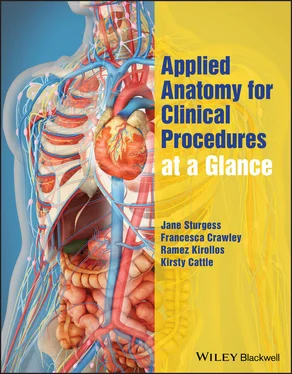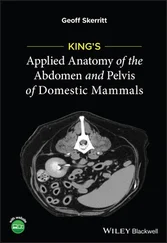1 Cover
2 Contributors Contributors Kirsty Cattle East of England Deanery Cambridge, UK Charles Crawley Addenbrooke’s Hospital Cambridge University Hospitals NHS Trust Cambridge, UK Francesca Crawley West Suffolk Hospital Bury St Edmunds, UK Olivia Kenyon East of England Deanery Cambridge, UK Ramez Kirollos Addenbrooke’s Hospital Cambridge University Hospitals NHS Trust Cambridge, UK Sherif Kirollos Addenbrooke’s Hospital Cambridge University Hospitals NHS Trust Cambridge, UK Jane Sturgess West Suffolk Hospital Bury St Edmunds, UK
3 1 Scrubbing up 1 Scrubbing up Sherif Kirollos and Ramez Kirollos Figure 1.1 Equipment. Figure 1.2 Before scrubbing, don hat, mask, eye protection. Figure 1.3 Recommended handwashing technique. Figure 1.4 Procedure. (a) Wash hands and arms three times (b) rinsing from fingertips to elbows between each wash. (c) Dry skin thoroughly, from hands down to elbows. (d) Don gown and gloves touching only the inside of each.
Equipment (Figure 1.1) Equipment ( Figure 1.1 ) Antiseptic solution [either povidone iodine (Betadine) or chlorhexidine] Gown Gloves Face mask Nail brush
Antiseptic solutions Antiseptic solutions The common antiseptics used for scrubbing are povidone iodine (Betadine) and chlorhexidine. These are applied to the skin and have a bactericidal or bacteriostatic effect, but complete asepsis (sterility) is not achieved. Chlorhexidine: This is a cationic polybiguanide which achieves both a bacteriostatic and bactericidal effect depending on its concentration, through the release of charged cations which bind to and disrupt the bacterial cell wall. This solution is effective against a broad range of organisms, including gram‐positive and gram‐negative organisms, aerobes, anaerobes, and yeasts. Povidone iodine: This is a solution containing a combination of iodine and polyvinylpyrrolidone (PVP). A bactericidal effect is achieved through the molecular iodine, and PVP acts as an iodophor to prevent irritation and toxicity to the tissue by keeping the free iodine concentration low. The solution acts against gram‐positive and gram‐negative bacteria, bacterial spores, viruses, protozoa, and fungi.
Procedure (Figure 1.4) Procedure ( Figure 1.4 ) 1 The hair is first covered by a hat and a mask is worn. Depending on the procedure protective eye goggles may be used. For specific procedures, a hooded surgical gown can be used ( Figure 1.2 ). 2 For the first scrubbing in of the day, handwashing should last for 5 minutes, and subsequent handwashing should allow 3 minutes each, following the recommended handwashing procedure ( Figure 1.3 ). 3 Any breach of the procedure requires recommencing of the cycle. 4 Antiseptic washing must cover all aspects of the skin of the hands and forearms, extending to the elbows. Particular attention should be paid to the interdigital spaces and under the nails. A brush may be used to apply the antiseptic solution to the skin under the nails but is best avoided elsewhere to avoid causing superficial skin abrasions with more vigorous scrubbing as that would expose underlying cutaneous bacteria. 5 During handwashing, ensure that hands and forearms remain elevated, allowing the water to drip from the elbow to avoid contamination as a result of water running from unsterile regions to areas already cleaned. Shaking should also be avoided for the same reason. 6 Throughout the handwashing cycles, ensure enough time is allowed for contact of the antiseptic with the skin before running it under water. 7 The skin is then dried with sterile towels while avoiding contact with unsterile regions ( Figure 1.4 c). 8 As contact with non‐sterile surroundings is prevented, the gown is then delivered from its sterile wrapping and donned ( Figure 1.4 d). 9 The arms and hands are kept within the sleeves until gloves are worn without touching their outer surface. This can be achieved by initially avoiding protruding the fingers through the gown sleeves. Alternatively, the surgeon is helped by an assistant or a scrub nurse holding open each pair of gloves.
4 2 Setting up a sterile field and draping the patient Equipment (Figure 2.1) Procedure Top tips
5 3 Three‐way tap Description of the three‐way tap Potential uses of the three‐way tap (Figure 3.3) Safe use of a three‐way tap After the procedure Anatomical pitfalls Top tips
6 4 Common equipment for core clinical procedures Needles Sampling devices
7 5 Local anaesthetic infiltration Classes of local anaesthetics (Figure 5.1) Mechanism of action Dose Side effects Technique Anatomical pitfalls Top tips
8 6 Obtaining consent Why do we obtain consent? Principles of obtaining consent if the patient has capacity Principles of obtaining consent if the patient does not have capacity Obtaining consent Responsibility for obtaining consent Discussing side effects/risk Verbal or written consent? (Figures 6.2 and 6.3) Consent in children
9 7 Manometer for central venous pressure and lumbar puncture What is a manometer line? What is normal pressure? Set‐up of the CSF manometer line Set‐up of the CVP manometer line Common anatomical pitfalls
10 8 Bladder irrigation sets Equipment Set‐up Common anatomical pitfalls Top tips
11 9 Underwater seal for chest drains Equipment (Figure 9.1) Connection (Figures 9.3 and 9.4) How does it work? (see Figure 9.2) Anatomical pitfalls Top tips
12 10 Male catheterisation Equipment (Figure 10.1) Procedure Contraindications Common problems
13 11 Female catheterisation Indications Equipment (Figure 11.1) Pre‐procedure Procedure Top tips
14 12 Arterial blood gases Equipment (Figure 12.1) Procedure Post‐procedure Allen’s test (Figure 12.3) Brachial and femoral stabs Common anatomical pitfalls Top tips
15 13 Performing an electrocardiogram Equipment (Figure 13.1) Procedure Anatomical (and other) pitfalls Top tips
16 14 Oropharyngeal airway Equipment (Figure 14.1) Technique (Figure 14.2) Aftercare Common anatomical pitfalls Top tips
17 15 Nasopharyngeal airway Equipment (Figure 15.1) Technique (Figure 15.2) Aftercare Common anatomical pitfalls Top tips
18 16 Laryngeal mask airway Equipment Technique Aftercare Common anatomical pitfalls Top tips
19 17 Central venous cannulation (high approach internal jugular) How to insert a central venous line Equipment (Figure 17.1) Technique (Figure 17.3) Landmarks for internal jugular vein (Figure 17.4) Aftercare Common complications
20 18 Central venous cannulation (low approach internal jugular) How to insert a central venous line Equipment (Figure 18.1) Technique (Figure 18.3) Landmarks for internal jugular vein (Figure 18.4) Aftercare Common complications
21 19 Central venous cannulation (subclavian) How to insert a central venous line Equipment (Figure 19.1) Technique (Figure 19.3) Aftercare Common complications Landmarks for subclavian vein (Figure 19.4) Top tips
22 20 Direct current cardioversion Indications Equipment (Figure 20.1) Contraindications Pre‐procedure Procedure Post‐procedure Top tip Pitfalls
23 21 Intercostal drains Requirements Equipment (Figure 21.1) Procedure – Seldinger technique Procedure – Surgical technique Anatomical (and other) pitfalls
24 22 Pleural tap Requirements Equipment (Figure 22.1) Procedure Anatomical (and other) pitfalls Complications
25 23 Inserting a nasogastric tube Equipment (Figure 23.1) Procedure Post‐procedure Contraindications to NGT insertion Pitfalls Top tips
26 24 Lumbar puncture Equipment (Figure 24.1) Technique Aftercare Common anatomical pitfalls Top tips
27 25 Bone marrow aspirate Equipment (Figure 25.1) Pre‐procedure Procedure Clotting requirements for a bone marrow aspirate
28 26 Ascitic tap Equipment (Figure 26.1) Contraindications Pre‐procedure Procedure Post‐procedure Top tips
Читать дальше












